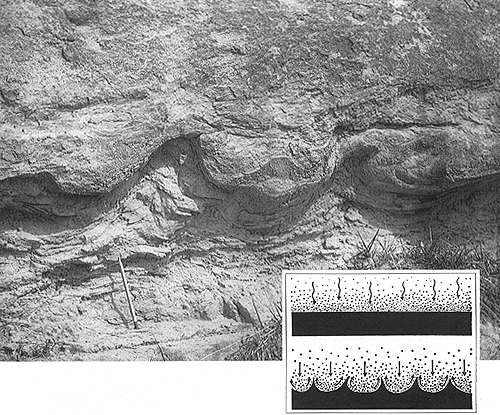
Load deformation: section view
Plate 122

Load deformation: section view
Plate 122
The production of post-depositional structures is often stimulated by the load of sediment (or ice, lava, and other materials, including artificial ones) on buried surfaces, in particular on interfaces between sediments with different physical properties. It may happen that a material of higher density (e.g., sand) rests on a less dense material (e.g., mud). The intervening surface is potentially unstable, because of the inverted density stratification. The sand tends to sink and the mud to inject upwards. A convective-like motion starts, but the attempts of the two "fluids" to overturn the bedding and replace each other abort at a certain stage owing to frictional resistance. The deformation is thus frozen, as in the example shown in this picture. Its geometry depends, among other things, by differences in viscosity between sand and mud.
More commonly, mud is more viscous; the resulting profile is a lateral alternation of rounded down bulging lobes of sand and narrower, pointed crests of mud ("flames "), as is seen in convolute laminae. The profile would be inverted if mud had a lower viscosity than sand. Lobes and flames have a vergence in some cases, which indicates that some slippage occurred along an inclined plane or (less probably in thick sand beds) that the buried interface felt the drag effect of a current.
The outcrop belongs to Messinian clastics of Marche region, central Apennines. Other examples of load structures are in color photos 3 and 9.
The elevated specific surface of its small particles gives a mud the property of cohesion, which increases with compaction and density. This implies that an applied stress can deform the mud and make it flow only when a critical, or threshold value is reached. Cohesion can be instantaneously lost if the mud has another property, thixotropy; when shaken, its gel structure is destroyed and it is transformed into a sol. In other terms, it liquefies. When the stress ceases, the sol spontaneously gelifies and stiffens. Both cohesion and thixotropy are related to the colloidal state, in which electrochemical forces are more important than gravity.
The mechanical disturbance that exceeds the cohesive resistance or annihilates cohesion can be provided by earthquakes, and consequently load structures could be also called seismites. For the reasons already discussed, however, this term should be avoided.